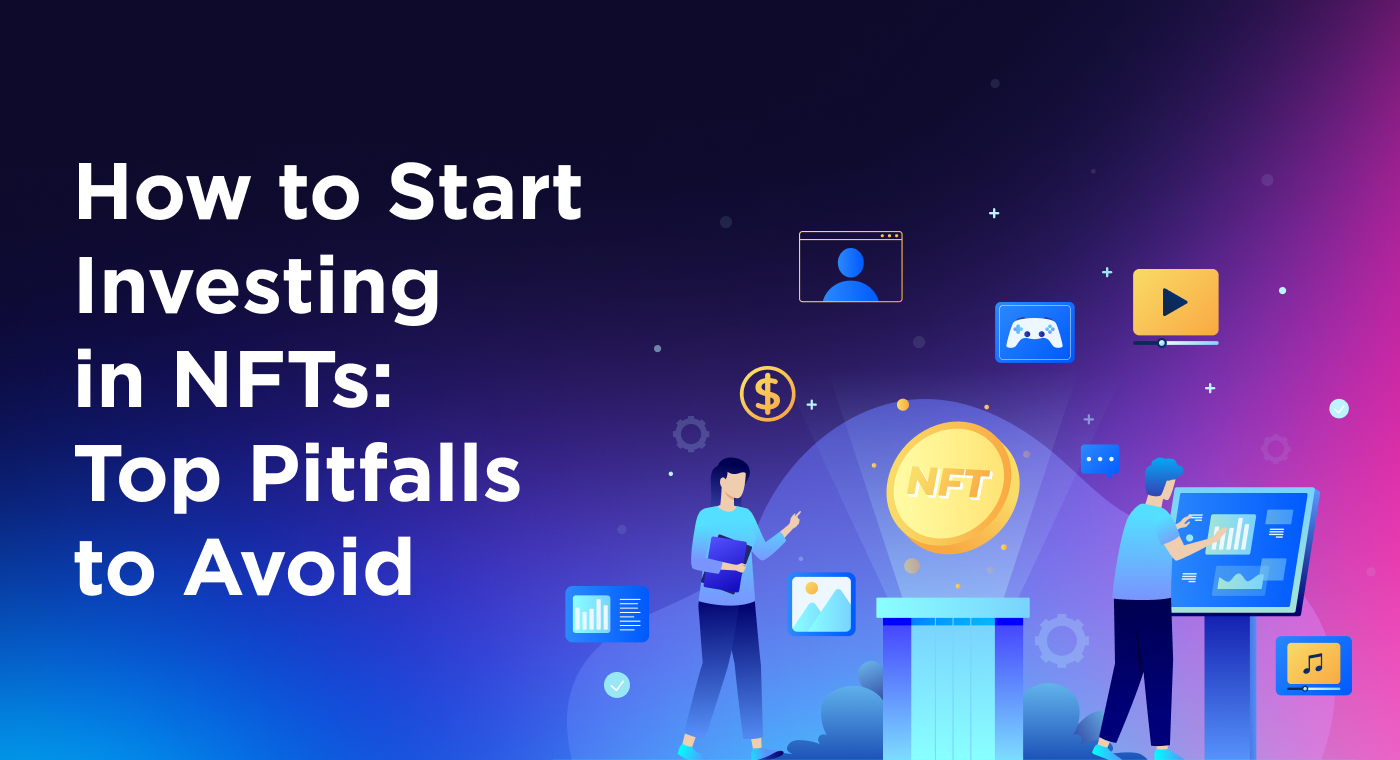Do you want to start investing in NFT and don’t know how to start? Find out how to invest in NFTs in detail, reviewing the best NFTs and the top pitfalls to avoid before you start to buy an NFT in 2022.
In the article below:
- How did NFTs become so popular?
- How do I invest in NFT stocks?
- Is it profitable to invest in NFT?
- Pros And Cons of Investing in NFTs
- What are the best NFT to invest in?
- Is it worth investing in NFT?
- What are the dangers of NFT?
When looking at the modern digital landscape, one has to acknowledge the simple fact that it is evolving at breakneck speed. Certainly, some of the technologies that had been prophesied in the early cyberpunk era of the 1980s and 1990s did not come into fruition yet, or have been developed with less than impressive results, but the digital space has surpassed all expectations.
Adherents of a more profound sci-fi approach will tout that holographic technologies are still a distant fantasy. Virtual Reality is cumbersome and lackluster with limited applications in mass use case scenarios. At the same time, a fully digitized scope of countless everyday services translated into a digital parallel world is nothing but pure futurism.
However, even the most fervent adherents of the idealistic futurism concept will have a hard time denying the fact that the development of blockchain technologies has significantly fast-tracked the arrival of a highly digitized and technologically-inclusive future.
The power of decentralization lies in its ability to break down barriers raised by a centralized system catering to the select few with the capital to spend. However, blockchain is fragmented and isolated into a series of networks, each operating in its own ‘island’ state, essentially raising its own barriers before users seeking to connect. This very factor of fragmentation is the single most important hurdle on the path of blockchain’s merger with the real world and its ability of acting as an off-ramp into the era of Web-3.0.
But for the Web-3.0 phenomenon to take effect with its semantics, natural language processing, permissionless access to knowledge and information, a key link is needed that would bridge the gap between the real and digital worlds. That bridge was developed and successfully deployed in late 2020 on the broader decentralized market in the form of the NFT — the Non-Fungible Token.
The NFT became a staple of the blockchain industry and a symbol of its accelerated integration into real economic sectors.
It is no understatement when NFTs are called a breakthrough technology, as their inherent technical qualities of immutability, security, solidification of ownership rights, and ability to be tethered to any asset, real or digital, allow them to be applied in an endless variety of use case scenarios.
The blockchain market is all about the funds floating around in its and the promises of multiplying investments that it bears. However, when it comes to investing in NFTs, one has to keep in mind that any decentralized asset is volatile by nature and its value is more of a subjective matter, or one based on the law of supply and demand. Risk is the omnipresent companion of any asset on the decentralized market and investors seeking to partake in it have to bear in mind that they stand the chance of losing most, if not all, of their investment at the whim of external factors.
How Did NFTs Become So Popular?
Interest in NFTs has been on the rise perpetually since the end of 2020, showing tremendous traction against the backdrop of a general market upheaval. Acting as the drivers of such innovative industries as NFT collecting, Play-to-Earn, metaverses, blockchain-based games, and others, NFTs have flooded the market, spoiling both investors and average users for choice.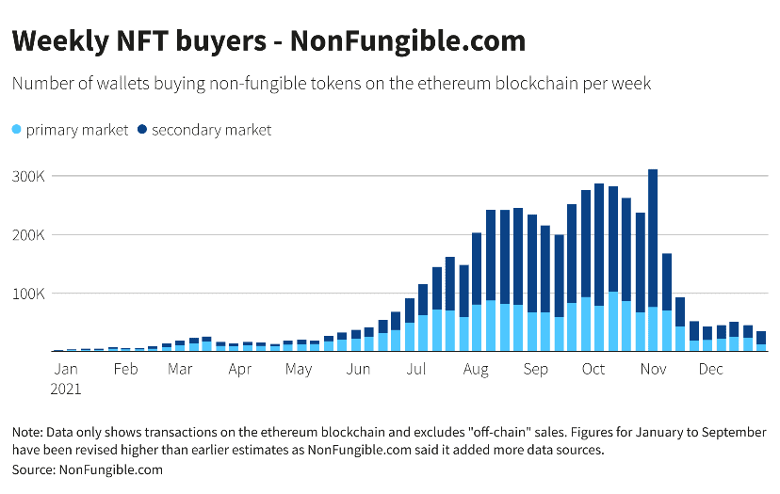
The volume of the NFT market on marketplaces has already exceeded $37 billion, reaching the same figures seen in 2021 during the peak of the sector’s development. That is precisely when an entirely new layer of users and audiences was formed — ones interested in collecting and using NFTs as assets within Play-to-Earn games, or as means of passive income generation and value storage. One needs but look at the price charts of the Bored Ape Yacht Club collection to realize the scale of the NFT craze throughout 2021 and early 2022.
With the onset of the ‘crypto winter’, activity on the NFT market has been rated as stabilizing in recent weeks in light of declining stock prices in the US and the desire of most investors to get rid of high-risk assets. But all markets are cyclical and bearish markets always give way to bull runs.
As such, aspiring investors expressing interest in getting involved in the NFT market should keep their noses up and maintain high vigilance in expectation of a market upturn.
While the market stabilizes, newcomers should start learning about how to start investing in NFTs. Sound reason and intuition are good guidelines alongside market knowledge are essential, since the decentralized market involves a high degree of risk and uncertainty. Experience and in-depth analysis are the best advisors in such matters. With the many ups and downs already potholing the NFT market, new investors should read a lot to avoid the pitfalls to invest in NFT crypto assets.
How do I invest in NFT stocks?
Investing in NFTs for beginners is one of the hardest things to start, as the abundance of assets on the market and the flood of related information can be overwhelming at times. That is why investors seeking to start on the path of NFT investing should first monitor the online space and identify several channels of information they deem credible and worthwhile.It is important to realize that the channels with the highest numbers of audiences are not always the best sources of credible information. Channels are created with the purpose of generating income from advertising, which is a crucial constituent of the decentralized market. As such, aggressive advertising and promotion are the name of the game in the highly competitive industry. The more a coin, cryptocurrency, NFT, or any other digital asset is advertised on a channel, the higher the chances that this is a case of paid advertising.
Worthwhile sources of information can be found in Telegram channels that are run by individual bloggers or traders. The latter have rather little interest in promoting a coin that they themselves do not invest heavily into. Top-tier media are good sources of firsthand information about market dynamics and a quasi-unbiased look at market prospects. Fundamental analysis is another important aspect that has to be considered and one that can be found across numerous professional websites that are unbiased by virtue of them being automated aggregators of market data.
Once an investor has acquired a basic understanding of the decentralized market, its driving forces, potential dangers, and the intricacies of the NFT market, it is time to start making the first step into the financial aspect.
The first and most important step in this regard would be to set up a digital wallet. Most of the mainstays of the decentralized wallet market like Metamask have long integrated the ability to accept, store and transfer NFTs. Some wallets like the Slavi Wallet are considered to be ideal in this regard due to their high degree of versatility, interconnectivity across numerous blockchains, and their dedicated sections designed for storing and showcasing NFT collections.
Once a wallet has been registered, investors have to delve into the realm of NFT marketplaces. These venues are specifically designed to host numerous NFT collections from various projects. Among the most popular platforms are Rarible and Opensea, which boast some of the highest turnovers on the market at $1,49 and $2.46 billion in latest sales volumes respectively. Both figures are still well below peak values.
There are numerous other marketplaces as well, since each and every one is designed to cater to a specific audience. Some, like the ChikoRoko Art project by Ilya Popov, the creator of the cult Smeshariki cartoon series, are more like curated exhibitions of modern art that bridge the physical art market with its digital manifestations. Others, like the Liquidifty platform, are more inclined to showcase collections of in-game assets and more niche NFT-based projects.
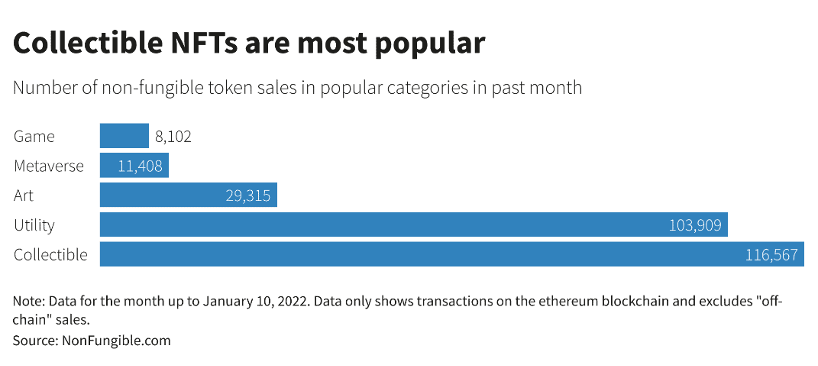
Another direction, innovative altogether, is the customizable NFT, as demonstrated by the Sharkrace project. It offers more than just collecting, but also lifelong value from collected assets, as well as VIP privileges, staking options, voting rights, and much more. Such projects are slowly becoming the new black in NFT space.
Once an investor has decided the direction of their investments and the types of assets that they are willing to start collecting, the next step is to top up the wallet and start buying the NFTs of interest.
Naturally, one has to first carefully evaluate the asset of interest based on a number of criteria.
- One such parameter is the usefulness of the NFT in terms of its applicability within the framework of a project, blockchain-based game, or sector of the real economy. Said usefulness will directly impact the demand for the NFT and its price on the market.
- Another parameter is the value of the NFT in both intrinsic and perceived terms. Certainly, perceived value is a personal matter that only the individual can evaluate through their desire to possess and showcase a certain piece of NFT art or a valuable in-game item. However, intrinsic value determines the ultimate price of the NFT on the market in terms of its resale value and potential for price growth on the wave of underlying project valuation or demand.
There are numerous other parameters that have to be taken into account, but the most important is the potential for valuation, as that is the ultimate essence of investing. If the issuing project of an NFT is showing poor traction and its community is not growing, chances are quite high that the asset will quickly depreciate in light of the drop in popularity of its platform. Investors, if they are interested in truly earning on their acquisitions, have to constantly monitor the market and be ready to sell NFTs on highs and buy the promising ones at launch or on lows.
Once the range of NFTs has been selected, the investor has to start purchasing. All NFT marketplaces sell NFTs on an auction basis. The auctions are timed and have two criteria for selecting the end buyer — the highest bidder that the seller agrees with within the set period, or the highest price at the end of the set auction time period. There are also fixed price sales without any auctions involved, at which buyers and sellers interact directly through the marketplace.
All investors have to keep in mind that NFT marketplaces charge a royalty. This is a certain percentage of the NFT’s price that will be deducted in favor of the platform. The royalty can also be deducted if the NFT is being sold on the secondary market. In this case, the fee will be directed to the original artist who created it. As such, some investors can easily lose up to 20% or even 30% off the initial price just in royalties when buying the asset.
Is it profitable to invest in NFT?
The answer of profitability is entirely related to the specific market cycle during which investment activities take place. During the initial bullish cycle of the NFT market in the period of late 2020 and the middle of 2021, NFTs were all the rage and investing in them was a highly profitable activity, as evidenced by such projects as Axie Infinity. However, as the example of the latter has shown, even the most profitable NFTs and related tokens of highly popular projects can sink catastrophically. As such, the question of profitability of investing in NFTs has a relative answer.Many aggregators like Nonfungible.com act as aggregators of market data and provide visual representations of dynamics across the NFT sector. The chart below gives a clear illustration of the topsy-turvy movements that the NFT market has been experiencing within the scope of a single week. The interesting thing to note is how the two lines of the number of sales in red and the volume of sales in white coincide to result in an inverse relationship. As the number of sales drops, their value in US Dollar terms increases.
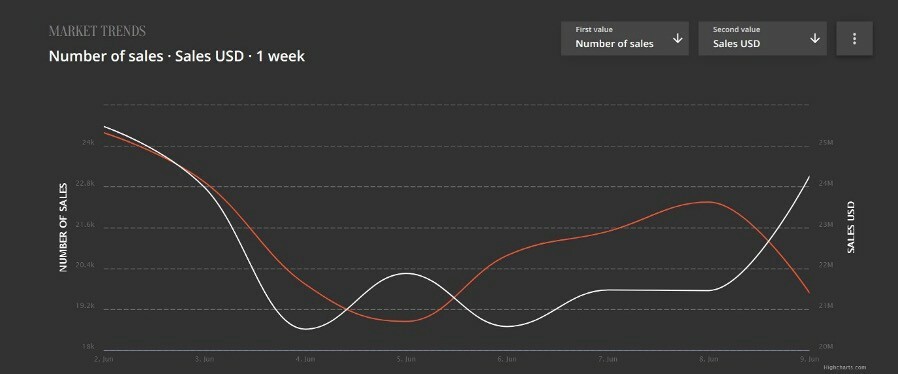
Pros And Cons of Investing in NFTs
When evaluating the overall idea of profitability of investing in NFTs, one has to consider the specifics of these digital assets in the first place. Like with all decentralized instruments, the pros and cons of NFTs are many, namely:Pros:
- Market-efficient
This versatility makes NFTs a promising technology that will eventually outgrow the hype stage to become mainstream and a viable investment instrument with lower degrees of attached volatility.
- Fractionizing ownership of digital assets
- Secure
- Cross-chain
Cons:
- Volatility
- Dubious intrinsic value
- Difficult to value
- High royalties
What are the best NFT to invest in?
The best NFTs to invest in are usually the ones that have retained the highest value based on the community supporting them. The higher the popularity of an NFT collection among users, the higher the chances that someone will be willing to buy a certain asset at a set price in case it is released onto the market.In light of the falling market, the best NFTs to invest in are those that have been deployed at the start of the NFT era in late 2020. Among them are:
- The Bored Ape Yacht Club
- Cryptopunks
- Meebits
- Decentraland
- Autograph.io
- Galaktic Gang Collection
The Bored Ape Yacht Club and Cryptopunk collections are staples of the NFT market that have attracted cult followings. The holders of assets from these collections identify themselves as select decentralized market participants and have a tight-knit community of followers with certain values and convictions stemming from their belief in the qualities and virtues of the blockchain. As such, the assets from these collections are prized not only by their holders, but also by those willing to acquire these unique and truly rare assets as investments for further resale.
Decentraland is another case, as it is a promising project that sells digital real estate. Said plots can be both sold and rented. Considering the fact that the number of plots is limited and the project is making good headway, prospects of appreciation are quite high in the future.
The development of the NFT market is ongoing and new types of NFTs are being fielded. One such type is the editable NFTs, which can be altered in their physical appearance and characteristics in accordance with the holder’s development in-game. The technology of customizable NFTs first introduced by the NFT and GameFi innovative project called SharkRace — makes the immutability factor obsolete and opens up entirely new prospects for the application of NFTs as value and trait carriers.
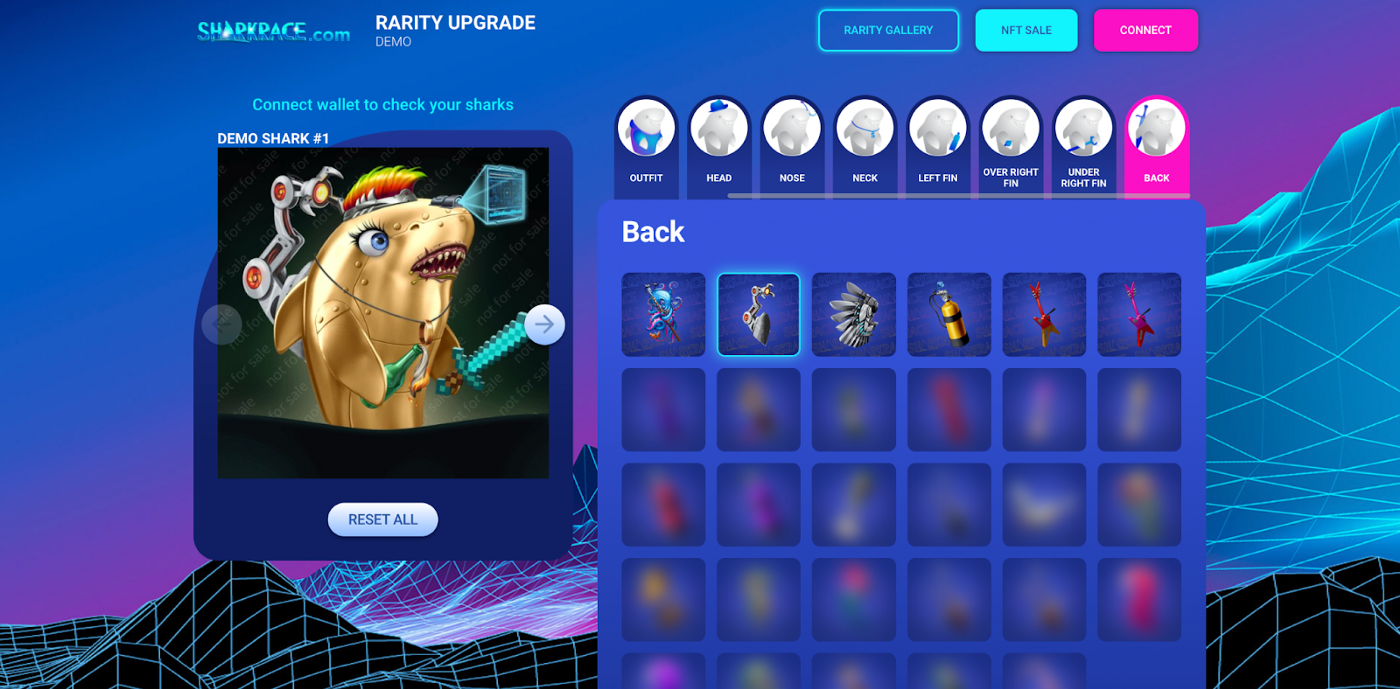
Is it worth investing in NFT?
In a nutshell, the question of worth should be closely tied to the question of risk. If one is risk-averse, then investing in such a dynamic market as NFTs is ill-advised. However, if the investor has the necessary experience and in-depth knowledge of the market with a portfolio to manipulate and capital to back on, then the NFT market can certainly provide ample opportunities for profit making.What are the dangers of NFT?
The two biggest mistakes NFT investors make can be summed up by their desire to make money too quickly and their poor choice of marketplace. Any attempt at rushing purchases or sales of NFTs without waiting for the opportune moment will result in financial losses. Improper selection of a marketplace without evaluation of its policies on royalties and auctions is a sure way of losing precious profit margins.Key Takeaways
When investing in NFTs:- Study the market;
- Decide which direction of NFT you are interested in;
- Separate intrinsic and perceived value;
- Bear in mind the marketplace caveats and commissions;
- Collect or trade, there is no middle;
- Keep an eye out on innovations.
However, careful analysis of the market and preliminary research of its distinguishing features is vital to avoid losing money on rushed actions and poor investment choices.
